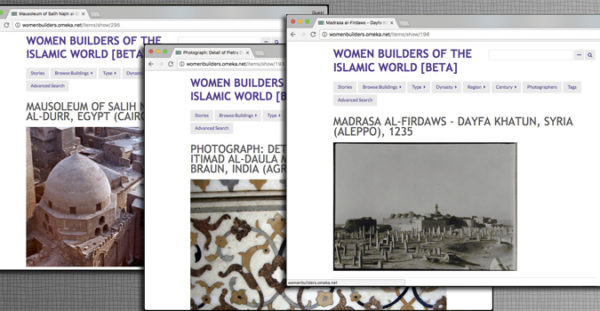A New Database of Muslim Women’s Patronage: Proof of Concept

Women have always been active in the Islamic cultural sphere as patrons of architecture. In the fall of 2016, I began collecting records of Muslim women’s patronage in the Islamic world to document their longstanding involvement.[1] The database covers a broad range of buildings: religious, secular, civic, residential, or some combination of all four. This breadth of architectural types balanced my narrow geographical focus on structures in Egypt, Syria, greater Iran, Turkey, and Mughal India. Issues of infrastructural preservation led me to include non-extant buildings in the database. Throughout the development of this database, I grappled with the relationship of women’s patronage to their visibility.
The first challenge in the creation of this database was deciding on the criteria for inclusion. Following the work of feminist scholars such as Fatima Mernissi, Leslie Peirce, and D. Fairchild Ruggles, this database begins from the premise that a woman’s patronage is an assertion of her agency and visibility.[2] Thus in viewing commissions as an expression of the presence of women, I grappled with how to discuss buildings financed by men, in honor of women. Agra’s Taj Mahal, a lavish mausoleum built by the Mughal emperor Shah Jahan for his favorite wife Mumtaz Mahal, is intimately connected with Mahal’s physical body and forcefully asserts her presence, even in death, in a way that is similar to other complexes constructed by women.[3] The inclusion of buildings like the Taj Mahal reframe visibility, changing the focus from the corporeality of the patron to the representation of her. While this angle may have allowed me to discuss the social expectations that allowed for certain women to become visible, I decided that the inclusion of these buildings would have obscured the initial focus on women’s involvement. Ultimately, the Taj Mahal and its equivalents were hampering a discussion of women’s agency by placing too much weight on the already much discussed accomplishments of men.
The database was structured to focus primarily on the Arab World, North Africa, Iran, Turkey, and Mughal India. In replicating the standard biases of Islamic art history’s regional and temporal focus, my aim of broadening understandings of women’s patronage was only partially successful since it ignored the activities of women in understudied areas of the Islamic world such as western China or Indonesia. The inherited biases that led me to focus on the “centers” of the Islamic world also influenced my approach to their dynastic histories. I structured my examination of each dynasty around its most important cities, creating a clear geographical and temporal range, but one that obscured the continuation of women’s patronage outside of the specific cities in question. This led me to ignore the patronage of women like Nafisa al-Bayda, the favorite wife of Murad Bey, the Ottoman viceroy of Egypt in the late eighteenth century. Al-Bayda’s subsequent rise in status from a slave to the wife of a governor is reflected by her vast wealth and endowment of monumental architecture, such as a public water fountain in Cairo. Furthermore, her roles as both patron and diplomat expand our understanding of women’s lives in Islamic societies.[4] Focusing on imperial centers presents a static view of these diverse regions: by implying that such regions remain a stable area of inquiry for the outside observer, one risks employing an orientalist framework.[5] However, the incorporation of scholarship in Arabic, Farsi, and Turkish can help mitigate certain orientalist assumptions of Islamic art history by providing alternate methodologies and sources.
Despite the methodological problems inherent to this database, it does succeed at showing that women were actively involved in patronage throughout the periods and regions discussed. This focus challenges the assumption that Muslim women have lacked agency in the past. This database helps to bring nuance to the historical record and provide context for the vibrant contemporary patronage and artistic production by Muslim women. The database can be found at: womenbuilders.omeka.net.
Chelsea Baumgartner
[1] A discussion of non-Muslim women’s patronage in Islamic societies is outside the scope of this database. However, for an examination of cross-cultural women’s patronage in Mughal India see: D. Fairchild Ruggles, ed., “Women’s Wealth and Styles of Giving: Perspectives from Buddhist, Jain and Mughal Sites,” in Women, Patronage and Self-Representation in Islamic Societies (Albany: SUNY Press, 2000), 91–122.
[2] Fatima Mernissi, The Forgotten Queens of Islam, trans. Mary Jo Lakeland (Minneapolis: Polity Press, 1993); Leslie Peirce, The Imperial Harem: Women and Sovereignty in the Ottoman Empire (New York: Oxford University Press, 1993); D. Fairchild Ruggles, “Women, Patrons,” in Medieval Islamic Civilization: An Encyclopedia ed. Josef W. Meri (London: Routledge, 2005).
[3] Wayne E. Begley, “The Myth of the Taj Mahal and a New Theory of Its Symbolic Meaning,” The Art Bulletin 61, no. 1 (1979): 8.
[4] Doris Behrens-Abouseif, Islamic Architecture in Cairo: An Introduction (Leiden: Brill, 1989), 31.
[5] Edward W. Said, Orientalism (London: Penguin, 1978), 38.